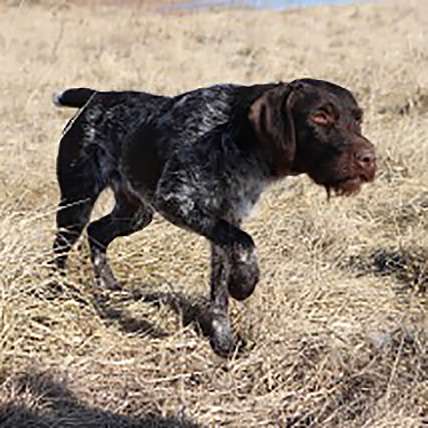Wirehaired Pointing Griffon
Bright, yellow-brown eyes look out from beneath bushy eyebrows as the Wirehaired Pointing Griffon surveys the field.
Wirehaired Pointing Griffon
A slow and methodical hunter who checks in with his handler regularly, he’s capable of pointing and retrieving both on land and in water. With a wiry double coat to protect him, he’s a versatile, medium-size hunter who is capable of bringing home feathered and furred game. He is an active, complex dog in need of an owner capable of matching his intelligence and activity level and recognizing his sensitive and soft nature when it comes to training.
Wirehaired Pointing Griffons are active and boisterous and love attention, though they may be a little standoffish with strangers. Some have a watchdog attitude while others are more laid back.
The breed takes well to training and enjoys learning. Use positive reinforcement techniques for best results and give your WPG plenty of praise and encouragement.
The dogs can be great companions for kids who are at least 6 years old, and they tend to get along well with other dogs. Puppies that are raised with cats often accept them as part of the family, but older WPGs who aren’t familiar with felines may simply view them as another type of prey. Keep them separated if you have any doubts at all.
Like most dogs, WPGs become bored when left to their own devices. They can become noisy or destructive if they don’t have other dogs to keep them company or don’t receive attention from their owners. But they thrive when they live with a family committed to giving them plenty of training, exercise, and attention.
The WPG’s greatest desire is to spend the day doing things with his family and relax with them in the evening. He is a people-loving dog who needs to live in the house.

Did You Know?
The American Kennel Club first registered a Griffon in 1887. At the time, the dog was called a Russian Setter.
Other Quick Facts
- The Wirehaired Pointing Griffon has a rectangular body and docked tail covered in a rough, coarse coat that makes him look as if he’s been dragged through a thicket. His squarish head, large yellow or brown eyes, hanging ears, mustache, and eyebrows give him a friendly expression.
- The WPG’s coat can be steel gray with brown markings, which is the preferred look; chestnut brown; roan, white, and brown; brown; white; or white and orange. One drawback of the preferred coloration is that the dog can be difficult to see in wooded areas.
- In Europe, the WPG is known as the Korthals Griffon, after the man who developed the breed. Whichever name you prefer, it’s a mouthful, so just call him a Griff.
| Adaptability | 3/5 |
| Affection Level | 4/5 |
| Apartment Friendly | 2/5 |
| Barking Tendencies | 3/5 |
| Cat Friendly | 4/5 |
| Child Friendly | 4/5 |
| Dog Friendly | 4/5 |
| Exercise Needs | 4/5 |
| Grooming | 3/5 |
| Health Issues | 2/5 |
| Playfulness | 4/5 |
| Shedding Level | 2/5 |
| Social Needs | 4/5 |
| Stranger Friendly | 3/5 |
| Territorial | 2/5 |
| Trainability | 4/5 |
| Watchdog Ability | 4/5 |
